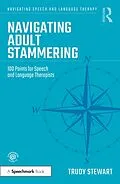This book, the first in an exciting new series, provides speech and language therapy students and newly qualified and beginning stammering specialists with 100 key points that will help form a strong foundation for their work supporting adults and teenagers who stammer.
Composed of practical, relevant and useful advice from an experienced clinician, chapters break advice down into sections which include information about the therapeutic relationship, therapeutic approaches and signposts to further resources. Throughout the book, comments from stammering specialists describe what they wish they had known at the start of their careers.
This book:
- Puts the person who stammers at the heart of therapy, following the clinical choices they might make
- Is written in an accessible style, designed to be dipped in and out of as required
- Draws on the experience of therapists working with those who stammer
Full of advice and guidance to support effective practice, this is an essential resource for anybody new to this client group.
Autorentext
Trudy Stewart is a retired consultant speech and language therapist. She studied in universities in Glasgow, Michigan State (USA) and Leeds. She worked in the UK with children and adults who stammer for nearly 40 years. Her last role was clinical lead of the Stammering Support Centre in Leeds. Trudy has taught undergraduate, graduate and specialist courses for clinicians in the UK, Europe and Sri Lanka, including on the European Clinical Specialisation in Fluency Disorders (ECSF) course. She has carried out research while a clinician, presented her work at international conferences and has written several texts on stammering.
Inhalt
Introduction Section A: The Person who Stammers Generic features State of self Stammering features Reasons for wanting therapy Knowledge about stammering Understanding of stammering Understanding of therapy Outcomes Stages of change Section B: The therapist Who am I to be? What would a client value from his clinician? The clinician's journey Being client centred Listening Acceptance and positive regard Empathy Using affirmations Summarising Humour Silence Reflective skills Specific skills Language and messages to the PWS Being an ambassador for the stammering community Section C: The therapeutic relationship The importance of the therapeutic relationship Rapport Openness Self disclosure The balance of power and control Ask the client Choice Flexibility/adaptability The relationship with the significant others Section D: Beginning sessions Finding out about the other Taking time to hear the narrative How to not use the case history Goal setting Assessments Formal assessments Informal assesssments Outcome based assessments Section E: Therapy: General points Service delivery Aspects of therapy common to all approaches: an overview Therapy approaches Effective therapy Principles of stammering therapy Pre-requisites Openness Desensitisation Voluntary stammering Avoidance reduction Section F: Therapy: Fluency modification or speak more fluently approach Using multiple strategies Targeting strategies Teaching fluency modification strategies Light contacts Prolongation of sounds Easy onset Rate control Breathing Section G: Therapy: Stammering modification or stammer more easily approach What is the stammering modification approach? Background Who to use stammering modification with? How to teach stammering modification Identification Variation Block modification Section H: Therapy: Stammer more proudly Opening comments What is 'Stammering Pride'? The Social Model of Disability Social model and stammering Critical theory Critical theory and stammering The therapy context Mobilisation of the stammering community Goals of 'Stammer More Proudly' Therapy and 'Stammer More Proudly' Section I: Psychology approaches The role psychological approaches play in the management of stammering What kind of psychological issues can develop in an adolescent and adult who stammers? What to do? Mindfulness Acceptance and commitment therapy (ACT) Personal Construct Psychology (PCP) and Therapy (PCT) Cognitive Behavioural Therapy (CBT) Narrative Practice (NP) Solution Focused Brief Therapy Section J: Maintaining positive outcomes and planning for the re-emergence of roles and behaviours Defining this stage How can such a period of difficulty be identified? Background Maintenance and its place in therapy Integration of strategies to manage setbacks in therapy What does a PWS need to be able to maintain his therapy gains Strategies for maintenance Endings Section K: Support Networks The context Significant Other (SO) as agents of change The nature of SO involvement in therapy The other side of stammering Support groups Final Thoughts What do I wish I had known from the start? The dance Appendix 1: Formal assessments currently in use Appendix 2: Cognitive Restructuring: learning to attach unhelpful thoughts
